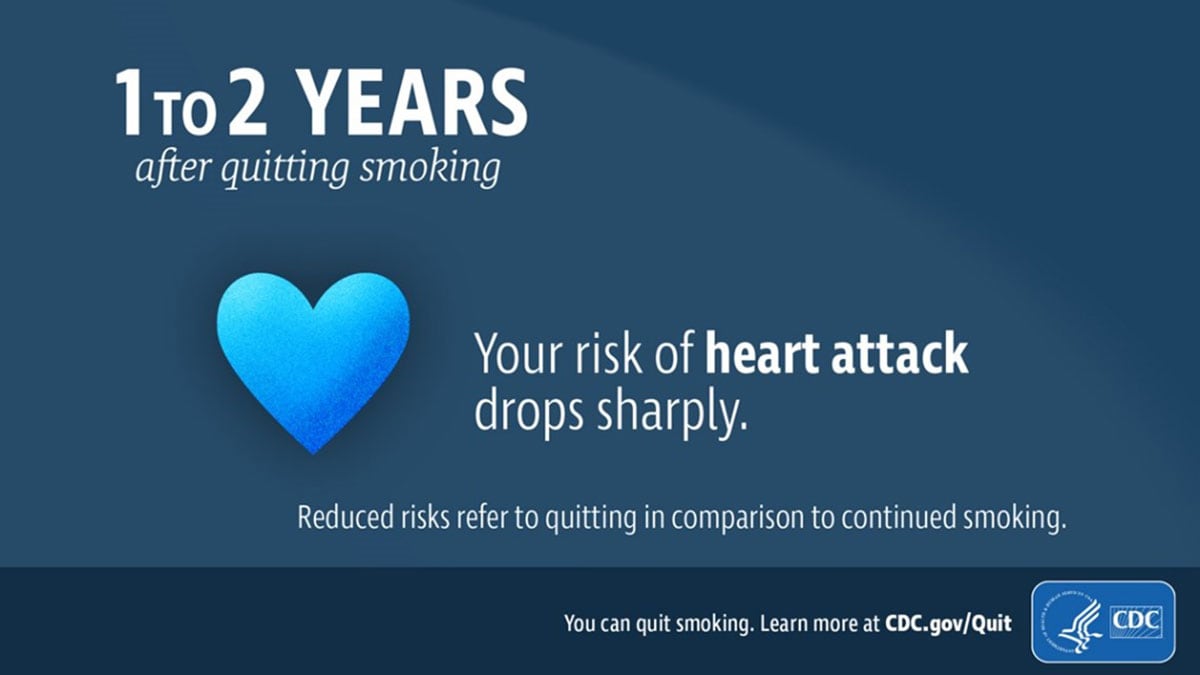At a glance
- Smoking is a major cause of cardiovascular disease (CVD) and is responsible for one in every four deaths from CVD.
- Secondhand smoke exposure causes heart disease and stroke.
- Quitting smoking can protect people from cardiovascular disease and death. People who already have heart disease also benefit from quitting smoking.

Cardiovascular disease overview
Cardiovascular diseases (CVDs) are diseases of the heart and blood vessels. CVDs include heart disease, stroke, and peripheral artery disease.1
Heart disease includes several types of heart conditions. In the United States, the most common type of heart disease is coronary heart disease (CHD). CHD is also known as coronary artery disease. CHD is caused by plaque buildup in the walls of the arteries that carry blood to the heart.23 Plaque is made up of deposits of cholesterol and other substances. It can cause the arteries to narrow over time. This process is called atherosclerosis. CHD can cause:
- Chest pain2
- Heart attack (when blood flow to the heart becomes blocked and a section of the heart muscle is damaged or dies)24
- Heart failure (when the heart cannot pump enough blood and oxygen to support other organs)25
- Arrhythmia (when the heart beats too fast, too slow, or irregularly)26
A stroke occurs when there is a blockage to the blood supply to the brain or when a blood vessel in the brain bursts. This causes parts of the brain to become damaged or die.7 Stroke can cause disability such as paralysis (loss of muscle movement), muscle weakness, trouble speaking, and memory loss.7 It can also cause death.7
Peripheral artery disease (PAD) is the narrowing or blocking of peripheral arteries. These arteries carry blood from the heart to other parts of the body.89 Similar to CHD, plaque in the arteries can cause this narrowing or blockage. PAD most commonly affects the legs and lower body. But it can also occur in the arms and upper body. Symptoms of PAD can include:
- Muscle pain during physical activity, like walking, that quickly gets better after resting.
- Feelings of weakness or numbness in the legs that make it feel harder to walk.
- Having one arm or leg feel colder than the other.
Smoking and cardiovascular disease
Smoking is a major cause of CVD, causing one in every four deaths from CVD.1
Smoking can:10
- Raise triglycerides (a type of fat in your blood)
- Lower "good" cholesterol (HDL)
- Make blood sticky and more likely to clot, which can block blood flow to the heart and brain
- Damage cells that line the blood vessels
- Increase the buildup of plaque in blood vessels
- Cause thickening and narrowing of blood vessels
Smoking increases the risk of many CVDs including:110
- Atherosclerosis
- Coronary heart disease (CHD), including heart attack and sudden cardiac death
- Stroke
- Peripheral arterial disease (PAD)
- Abdominal aortic aneurysm
Estimates show that smoking increases the risk for coronary heart disease by 2 to 4 times and for stroke by 2 to 4 times compared to not smoking.1 Even people who smoke fewer than five cigarettes a day can have early signs of cardiovascular disease.1
Secondhand smoke exposure and cardiovascular disease
Secondhand smoke is the smoke from burning tobacco products like cigarettes, cigars, pipes, or hookahs. Secondhand smoke exposure occurs when people breathe in smoke from burning tobacco products. Exposure also occurs when people breathe in smoke breathed out by a person smoking.1101112 Exposure to secondhand smoke increases the risk for coronary heart disease and stroke.110111213
- Each year in the United States, secondhand smoke causes nearly 34,000 deaths from coronary heart disease among people who do not smoke. It also causes more than 8,000 deaths from stroke among people who do not smoke.
- People who do not smoke but breathe secondhand smoke at home or at work increase their risk of developing heart disease by 25%–30%.
- Secondhand smoke increases the risk for stroke by 20%−30%.
- Breathing secondhand smoke, even for a short time, can damage blood vessels and cause blood to become stickier. These changes can increase the risk of having a heart attack.
Quitting smoking can protect people from cardiovascular disease
Quitting smoking is one of the most important actions people who smoke can take to reduce their risk for cardiovascular disease and death. This is true for all people who smoke, regardless of age or how long or how much someone has smoked.13
Quitting smoking:13
- Reduces markers of inflammation and hypercoagulability (a condition where blood is more likely to form blood clots)
- Improves "good" cholesterol (HDL)
- Reduces the development and progression of atherosclerosis
- Reduces the risk of coronary heart disease*
- Reduces the risk of stroke*
- Reduces the risk of abdominal aortic aneurysm*
*Reduced risk refers to quitting smoking in comparison to continued smoking.
Research also suggests that quitting smoking may reduce the risk of:
- Atrial fibrillation
- Sudden cardiac death
- Heart failure
- Venous thromboembolism
- Peripheral arterial disease
People who already have coronary heart disease also benefit from quitting smoking. Quitting smoking can lower the risk of having another heart attack and the risk of dying from heart disease.13
After quitting smoking, the risk of cardiovascular disease drops rapidly and then continues to decrease over time:13
- 1 to 2 years after quitting, risk of heart attack drops sharply
- 3 to 6 years after quitting, added risk of coronary heart disease drops by half
- 5 to 10 years after quitting, risk of stroke decreases
- 15 years after quitting, risk of coronary heart disease drops to close to that of someone who does not smoke

- U.S. Department of Health and Human Services. The Health Consequences of Smoking—50 Years of Progress: A Report of the Surgeon General. Atlanta: U.S. Department of Health and Human Services, Centers for Disease Control and Prevention, National Center for Chronic Disease Prevention and Health Promotion, Office on Smoking and Health, 2014. Accessed April 24, 2024. https://www.ncbi.nlm.nih.gov/books/NBK179276/pdf/Bookshelf_NBK179276.pdf
- Centers for Disease Control and Prevention. About Heart Disease. Accessed April 24, 2024. https://www.cdc.gov/heart-disease/about/index.html
- U.S. National Library of Medicine. Coronary Heart Disease. Accessed April 24, 2024. https://medlineplus.gov/ency/article/007115.htm
- Centers for Disease Control and Prevention. Heart Attack. Accessed April 24, 2024. https://www.cdc.gov/heart-disease/about/heart-attack.html
- Centers for Disease Control and Prevention. Heart Failure Fact Sheet. Accessed April 24, 2024. https://www.cdc.gov/heart-disease/about/heart-failure.html
- National Heart, Lung, and Blood Institute. What is an Arrhythmia? Accessed April 24, 2024. https://www.nhlbi.nih.gov/health-topics/arrhythmia
- Centers for Disease Control and Prevention. About Stroke. Accessed April 24, 2024. https://www.cdc.gov/stroke/about/index.html
- Centers for Disease Control and Prevention. Peripheral Arterial Disease (PAD). Accessed April 24, 2024. https://www.cdc.gov/heart-disease/about/peripheral-arterial-disease.html
- National Heart, Lung, and Blood Institute. Peripheral Artery Disease - What Is Peripheral Artery Disease? Accessed April 24, 2024. https://www.nhlbi.nih.gov/health/peripheral-artery-disease
- U.S. Department of Health and Human Services. How Tobacco Smoke Causes Disease: The Biology and Behavioral Basis for Smoking-Attributable Disease: A Report of the Surgeon General. Atlanta: U.S. Department of Health and Human Services, Centers for Disease Control and Prevention, National Center for Chronic Disease Prevention and Health Promotion, Office on Smoking and Health, 2010. Accessed April 24, 2024. https://www.ncbi.nlm.nih.gov/books/NBK53017/
- Institute of Medicine. Secondhand Smoke Exposure and Cardiovascular Effects: Making Sense of the Evidence. Washington: National Academy of Sciences, Institute of Medicine, 2009. Accessed April 24, 2024. https://www.ncbi.nlm.nih.gov/books/NBK219565/pdf/Bookshelf_NBK219565.pdf
- National Toxicology Program. Report on Carcinogens, Fourteenth Edition. Research Triangle Park (NC): U.S. Department of Health and Human Services, Public Health Service, 2016. Sense of the Evidence. Washington: National Academy of Sciences, Institute of Medicine, 2009. Accessed April 24, 2024. https://ntp.niehs.nih.gov/pubhealth/roc/index-1.html
- U.S. Department of Health and Human Services. Smoking Cessation: A Report of the Surgeon General. Atlanta, GA: U.S. Department of Health and Human Services, Centers for Disease Control and Prevention, National Center for Chronic Disease Prevention and Health Promotion, Office on Smoking and Health, 2020. Accessed April 24, 2024. https://www.hhs.gov/sites/default/files/2020-cessation-sgr-full-report.pdf
